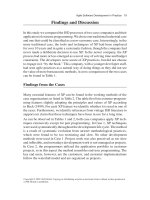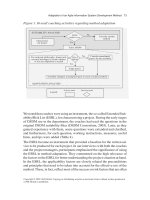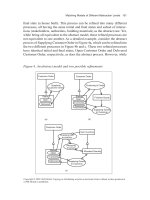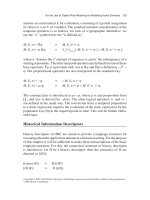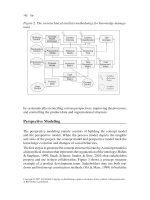Systems analysis and development CIS210 ch 14
Bạn đang xem bản rút gọn của tài liệu. Xem và tải ngay bản đầy đủ của tài liệu tại đây (64.77 KB, 12 trang )
CIS 210
Systems Analysis
and Development
Week 8 Part II
Designing Distributed
and Internet Systems
Objectives
• Upon completion of part II you will be able to:
– Understand and be able to explain the concepts related to
client server architecture, local area networking, distributed
databases and middleware
– Understand and be able to explain the concepts related to file
server and client server environments
– Understand and be able to explain the concepts related to
distributed systems and their trade-offs
– Understand and be able to explain the concepts related to web
site management and customer loyalty and trustworthiness
– Understand and be able to explain the concepts related to
online data, transaction processing, analytical processing and
data warehousing
Overview
• Advances in Technology
– GUIs
– Networking
– Internet
•
•
•
•
Opportunities
Competitive Pressures
Technologies Being Used
Capabilities and Issues
Designing Distributed
and Internet Systems
• The Process of Designing Distributed and
Internet Systems
– More design issues
– More components
• Deliverables and Outcomes
–
–
–
–
Description
Data usage
Business processes
Contrasts of alternative IS architectures
Designing
Distributed Systems
• Designing Systems for LANs
– Local area network
– File servers
• Manages file operations
• Limitations
– Excessive data movement
– The need for a powerful client workstation
– Decentralized data control
Designing
Distributed Systems
• Designing Systems for Client/Server Architecture
– Client
• Managing the user interface
– Server
• Database storage
• Access
– Benefits
•
•
•
•
Benefits leverage
Reduced response time and network traffic
GUI techniques
Open systems
Designing
Distributed Systems
• Choosing Between File Server and Client/Server
– Client/server
• Supports distribution of data
• Supports distribution of processing
• Advanced Forms of Client/Server Architectures
– Functions
• Data management
• Data presentation
• Data analysis
– Three tiered client/server
– Middleware
Designing
Internet Systems
• Internet Design Fundamentals
– Standards drive the Internet
• BIND
• HTTP
• HTML
– Separating content and display
• XML
– Future evolution
• Thin client
• Wireless
– WAP
– WML
Designing
Internet Systems
• Site Consistency
– Cascading style sheets
• Simplify site maintenance
• Ensure consistency
– Extensible style language
• Separating style from content
• Methods for transforming
• Methods for formatting
– Other consistency issues
• Page and link titles
– Unique titles
– Choose words carefully
Designing
Internet Systems
• Design Issues Related to Site Management
– Customer loyalty and trustworthiness
•
•
•
•
Design quality
Disclosure
Comprehensive, correct, current
Connected to the Web
– Personalization
– Customization
– Web pages must live forever
•
•
•
•
Bookmarks
Links from other sites
Search engines
Added value
– System security
• Striking a balance
Designing
Internet Systems
• Managing Online Data
– Context development
• Integration depth
• Organizational breadth
– Online transaction processing
– Online analytical processing
– Data warehousing
•
•
•
•
Subject oriented
Integrated
Time-variant
Non-volatile
– Enterprise data warehouse
– Data marts
Summary
•
•
•
•
•
•
•
•
Process of designing distributed and Internet systems
Designing systems for LANs
Designing systems for client/server architecture
Choosing between file/server and client/server
architecture
Internet design fundamentals
Providing site consistency
Internet system design issues
Managing online data


